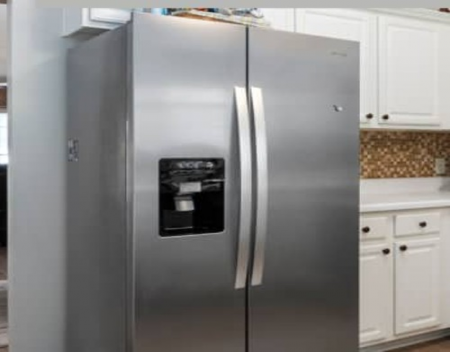Tipos de aparatos
- Aire acondicionado
- Automobile
- Chainsaw
- Circular Saw
- Lavaplatos
- Drills
- Secadora
- Drywall Screw Gun
- Horno
- Gas Fireplace
- Gas Grill
- Gas Patio Heater
- Grinder
- Heat Pump
- Impact Driver
- Impact Wrench
- Microonda
- Nailer
- Orbital Sander
- Calentadores de piscina
- Powerwall
- Distancia
- Refrigerador
- Television
- Lavadora
- Calentador de agua
Marcas de electrodomésticos
- A.O. Smith
- AccuCold
- Admiral Craft
- AGA
- Airrex
- Amana
- Ambiance
- American Range
- American Standard
- American Water Heaters
- Aquacal
- Armstrong
- Asko
- Avanti
- Avenlur
- Azure
- Beko
- Bellfires
- Bertazzoni
- Blackstone
- Blaze
- Blomberg
- BlueStar
- Bosch
- Bradford White
- Bromic
- Bryant
- Cafe
- Calcana
- Capital
- Carrier
- Char-Broil
- Char-Griller
- Chrysler
- Coates
- Coleman
- Comfortmaker
- Commercial Chef
- Continental
- Cosmo
- Cove
- Crown Verity
- Dacor
- Daikin
- Danby
- Danfoss
- DaVinci
- DCS
- Deco
- DeWALT
- Ducane
- Dyna-Glo
- Dyson
- EcoSmart
- Electrolux
- Element4
- Empava
- Equator
- Eurodib
- European Home
- Everdure
- Farberware
- Fhiaba
- FibroPool
- Fire Sense
- Fisher
- FiveStar
- Flare
- Flash Furniture
- Focus
- Ford
- Forno
- Forte
- Frigidaire
- Fulgor Milano
- Gaggenau
- GE
- General Motors
- GlowBrand
- Goodman
- Grundig
- GSW
- Haier
- Hayward
- Heatstar
- Heil
- Hestan
- Hisense
- Hitachi
- Hotpoint
- iio
- Ilve
- Impecca
- Ingignia
- Insignia
- JennAir
- John Wood
- Keeprite
- Kenmore
- Kenyon
- KitchenAid
- Kucht
- La Cornue
- Lennox
- LG
- Liebherr
- Lifetime
- Lion
- Luxaire
- Lynx
- Magic Chef
- Marvel
- Maytag
- McQuay
- MicroFridge
- Midea
- Miele
- Migali
- Monogram
- Montigo
- Mr Heater
- Napoleon
- Navien
- Nexgrill
- Noritz
- Panasonic
- Patio Comforts
- Payne
- Pentair
- Perlick
- PITT
- Premier
- Raypak
- Real Fyre
- Regency
- Reliance
- Rheem
- Rinnai
- Roma
- Ruud
- Saber
- Samsung
- Schwank
- Sharp
- Smeg
- Solas
- Sony
- Spartherm
- Speed Queen
- StaRite
- State Water Heaters
- Stiebel Eltron
- SubZero
- Summerset
- Summit
- SunGlo
- SunPak
- Sunpentown
- SunStar
- Superiore
- Takagi
- TCL
- TEC
- Tempstar
- Tesla
- Thermador
- Thor Kitchen
- Toshiba
- Town and Country
- Toyota
- Traeger
- Trane
- Twin Eagles
- U-Line
- Unique
- Vaillant Group
- Valor
- Verona
- Victory
- Viessmann
- Viking
- Vizio
- Weber
- Westinghouse
- Whirlpool
- Whynter
- York
- ZLINE
Categorías de artículos
- Aire Acondicionado
- Cuidado de los electrodomesticos
- Appliance News
- Dishwasher News
- Maquinas de secado
- Hornos
- Gas Fireplaces
- Microondas
- Calentadores de piscina
- Frigorificos
- Estufas - Cocinas
- Trucos y consejos
- Lavadoras
- Water Heaters
Más artículos
My Refrigerator is Too Cold

We all expect our fridge to keep our food and drinks cold. What do you do when the fridge is cooling too much and your fridge is freezing food? There are usually some simple reasons why your fridge is too cold. Let us walk you through some of them and show you some simple fixes.
Problem with an air inlet damper.
This is the part of your refrigerator that balances the airflow from the housing of the evaporator fan. It is usually located where chilled air enters the food holding portion of a fridge and can look like louvered blinds on a window. It is often found at the bottom of the interior of your fridge.
You will be able to tell the difference between this part and the cold control of your fridge because the knob that controls this damper does not have an “off” setting. If this part does not open and closes easily, it may be letting too much cold air into the fridge and create a refrigerator running too cold.
Main control board issues.
Most newer models of refrigerators have all of their components controlled by a main electronic control board. Since this board controls so many parts of your refrigerator, it is always best to check all other parts of your fridge if it is getting too cold and leave this as the last option.
If you do suspect an issue with the board, unplug your fridge and inspect the board. Look for any sign of burnt connections, foil that may have deteriorated or any sign that electrical arcing has occurred. All of these items would be a sign of a faulty control board which causes your refrigerator to run continuously and get far too cold in the process.
Temperature controller.
If your refrigerator is too cold on the lowest setting the issue could be that there is a faulty temperature controller. This is a switch that sends electricity to the compressor and fans and this is caused by a change in temperature in the fridge, as sensed by the thermostat, such as when it begins to get too warm inside the fridge.
If the fan and the compressor are working but the fridge is too cold, this could be a sign that the temperature controller is faulty. In this case, it will not be sensing the actual temperature of the fridge and may cause your fan and compressor to run far too often thus resulting in a fridge that is too cold.
Replace the air inlet.
If the air inlet is not moving properly the best course of action is to replace the part. On some models, air leakage is kept down by a foam seal that may be rather rigid so take care not to damage this part when replacing the inlet.
If your refrigerator contains an automatic temperature-sensing bulb, make sure that it is positioned properly after replacing the inlet. This bulb measures the temperature inside the fridge and then adjusts the inlet control accordingly.
Replace a damaged or faulty control board.
If after inspection of your control board you do see signs of damage there is no choice but replacement of the entire board. Since this does control so many components of the refrigerator it is vital to do this job correctly.
It is imperative to make sure the fridge is first unplugged before doing any work on an electrical component like the control board.
Reset, repair, or replace a temperature control.
Troubleshooting a temperature control issue is a fairly straightforward process. To start, unplug your fridge and then find your cold control knob.
Set the knob at its midpoint and then plug your fridge back in. At this setting, your fridge should maintain a temperature of about 38 degrees Fahrenheit.
When doing this, check to make sure the sensor bulb or wire is in place with no signs of damage. Also, check the wires to make sure they are not loose or corroded.
After you have done all this, check on your fridge for a day or so to see if it is maintaining the correct temperature. If it is not, it may be time to replace the control.
SOURCE: fixappliances.ca

We all expect our fridge to keep our food and drinks cold. What do you do when the fridge is cooling too much and your fridge is freezing food? There are usually some simple reasons why your fridge is too cold. Let us walk you through some of them and show you some simple fixes.
Problem with an air inlet damper.
This is the part of your refrigerator that balances the airflow from the housing of the evaporator fan. It is usually located where chilled air enters the food holding portion of a fridge and can look like louvered blinds on a window. It is often found at the bottom of the interior of your fridge.
You will be able to tell the difference between this part and the cold control of your fridge because the knob that controls this damper does not have an “off” setting. If this part does not open and closes easily, it may be letting too much cold air into the fridge and create a refrigerator running too cold.
Main control board issues.
Most newer models of refrigerators have all of their components controlled by a main electronic control board. Since this board controls so many parts of your refrigerator, it is always best to check all other parts of your fridge if it is getting too cold and leave this as the last option.
If you do suspect an issue with the board, unplug your fridge and inspect the board. Look for any sign of burnt connections, foil that may have deteriorated or any sign that electrical arcing has occurred. All of these items would be a sign of a faulty control board which causes your refrigerator to run continuously and get far too cold in the process.
Temperature controller.
If your refrigerator is too cold on the lowest setting the issue could be that there is a faulty temperature controller. This is a switch that sends electricity to the compressor and fans and this is caused by a change in temperature in the fridge, as sensed by the thermostat, such as when it begins to get too warm inside the fridge.
If the fan and the compressor are working but the fridge is too cold, this could be a sign that the temperature controller is faulty. In this case, it will not be sensing the actual temperature of the fridge and may cause your fan and compressor to run far too often thus resulting in a fridge that is too cold.
Replace the air inlet.
If the air inlet is not moving properly the best course of action is to replace the part. On some models, air leakage is kept down by a foam seal that may be rather rigid so take care not to damage this part when replacing the inlet.
If your refrigerator contains an automatic temperature-sensing bulb, make sure that it is positioned properly after replacing the inlet. This bulb measures the temperature inside the fridge and then adjusts the inlet control accordingly.
Replace a damaged or faulty control board.
If after inspection of your control board you do see signs of damage there is no choice but replacement of the entire board. Since this does control so many components of the refrigerator it is vital to do this job correctly.
It is imperative to make sure the fridge is first unplugged before doing any work on an electrical component like the control board.
Reset, repair, or replace a temperature control.
Troubleshooting a temperature control issue is a fairly straightforward process. To start, unplug your fridge and then find your cold control knob.
Set the knob at its midpoint and then plug your fridge back in. At this setting, your fridge should maintain a temperature of about 38 degrees Fahrenheit.
When doing this, check to make sure the sensor bulb or wire is in place with no signs of damage. Also, check the wires to make sure they are not loose or corroded.
After you have done all this, check on your fridge for a day or so to see if it is maintaining the correct temperature. If it is not, it may be time to replace the control.
SOURCE: fixappliances.ca




